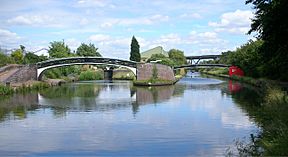Bromford Junction facts for kids
Bromford Junction is a special place where different parts of a canal meet. It's located near Oldbury in the West Midlands, England. Think of it like a crossroads for boats! This junction is at the bottom of the Spon Lane Locks. Here, the Spon Lane Locks Branch connects with the main canal route, called the BCN New Main Line.
Contents
History of the Canals
Canals are like watery roads built for boats. They were very important for moving goods, especially coal, a long time ago. The area around Bromford Junction has a rich history with these waterways.
The First Canals
The story of Bromford Junction began with the Wednesbury Canal. This canal was part of the larger Birmingham Canal system. It was approved by the government in 1768. Because there were many coal mines in Wednesbury, this part of the canal was built first. It opened in 1769. This allowed a lot of coal to be moved to Birmingham, which was very profitable.
Dealing with Hills: Locks!
Canals need to be level, but the land isn't always flat. To get boats up and down hills, engineers built "locks." Locks are special chambers that fill with water to raise or lower boats.
Near Bromford Junction, there were six Spon Lane Locks. These locks lifted boats from 453 feet to a high point of 491 feet. At another place called Smethwick, six more locks dropped the canal back down to the same level. This level was known as the Birmingham Level.
The main canal line to Wolverhampton was completed in 1772. It left the Spon Lane Locks at a different level, 473 feet, and stayed at that height. Then, it dropped through many locks to reach another canal.
Problems and Solutions
Having so many locks to go up and over the Smethwick "summit" caused problems. Boats often got stuck in traffic jams, and there wasn't always enough water for all the locks.
In the 1790s, some changes were made to help. A new section of canal was built. This removed the need for three locks at each end of the summit. But it didn't completely solve the issues.
Telford's Big Plan
In 1825, a famous engineer named Thomas Telford was asked to improve the main canal line. Telford was known for building very straight canals. He used big embankments, deep cuttings, and tunnels to keep the canal level.
His new main line left the old canal at Factory Locks. It then followed a straight path to Pudding Green Junction. The old Wednesbury Canal was made wider and straighter in this area. It became part of the new main line.
To avoid the old locks over Smethwick, Telford dug a huge cutting. This was like a giant ditch, up to 71 feet deep in some places! It went slightly south of the original canal. The old canal from the top of the Spon Lane Locks was carried over this new cutting by a bridge called Stewart Aqueduct.
New Junctions and a Shorter Route
Telford's improvements created two new junctions. Bromford Junction was at the west end of the cutting. Smethwick Junction was at the east end. This new bypass opened on December 18, 1829.
When Telford's new main line was finished, it made the canal much shorter. It cut down the winding route by 7.5 miles! This made canal travel much faster and more efficient.
Where is Bromford Junction?
Bromford Junction is a busy spot on the canal network. To the west, the canal is level for about 3.3 miles. It passes Pudding Green Junction and the Wednesbury Canal along the way. To the east, the canal is level for about 4.8 miles until it reaches Worcester Bar.
The branch to Spon Lane Locks also goes east. It runs almost next to Telford's new canal. The first of the three Spon Lane locks is just a short distance along this branch.
Special Bridges
At Bromford Junction, you can see two special bridges. They are made of cast iron and were built at Horseley Ironworks in Tipton. These bridges carry the towpath, which is the path next to the canal where horses used to pull boats.
One bridge crosses the Spon Lane Locks Branch. It has a curved arch and is made of brick and sandstone. It has an inscription that says "Horseley Iron Works 1829." This bridge is considered a grade II listed structure. This means it's an important historical building that needs to be protected.
The other bridge crosses the new main line. It looks similar but was made in 1848 by "The Horseley Company Tipton." The Spon Lane Locks themselves are also grade II listed, showing their historical importance.



